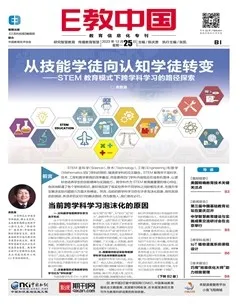Technology in education: A TOOL ON WHOSE TERMS?(Ⅱ) 譯題:技術運用于教育:誰來做主?(二)Product by UNESCO 聯合國教科文組織
KEY MESSAGES
The fast pace of change in technology is putting strain on education systems to adapt.
Countries are starting to define the digital skills they want to prioritize in curricula and assessment standards.Globally, 54% of countries have digital skill standards but often these have been defined by non-state, mostly commercial, actors.
Many students do not have much chance to practise with digital technology in schools. Even in the worlds richest countries, only about 10% of 15-year-old students used digital devices for more than an hour per week in mathematics and science.
Teachers often feel unprepared and lack confidence teaching with technology. Only half of countries have standards for developing teacher ICT skills. While 5% of ransomware attacks target education, few teacher training programmes cover cybersecurity.
Various issues impede the potential of digital data in education management. Many countries lack capacity: Just over half of countries use student identification numbers. Countries that do invest in data struggle: A recent survey among UK universities found that 43% had trouble linking data systems.
Online content has grown without enough regulation of quality control or diversity.
Online content is produced by dominant groups, affecting access to it. Nearly 90% of content in higher education repositories with open education resource collections was created in Europe and Northern America; 92% of content in the OER Commons global library is in English. Massive open online courses (MOOCs) mainly benefit educated learners and those from richer countries.
Higher education is adopting digital technology the fastest and being transformed by it the most. There were over 220 million students attending MOOCs in 2021. But digital platforms challenge universities role and pose regulatory and ethical challenges, for instance related to exclusive subscription deals and to student and personnel data.
Technology is often bought to plug a gap, with no view to the long-term costs ...
... for national budgets. The cost of moving to basic digital learning in low-income countries and connecting all schools to the internet in lower-middle-income countries would add 50% to their current financing gap for achieving national SDG 4 targets. Money is not always well spent: Around two-thirds of education software licences were unused in the United States.
... for childrens well-being. Childrens data are being exposed, yet only 16% of countries explicitly guarantee data privacy in education by law. One analysis found that 89% of 163 education technology products recommended during the pandemic could survey children. Further, 39 of 42 governments providing online education during the pandemic fostered uses that risked or infringed on childrens rights.
... for the planet. One estimate of the CO2 emissions that could be saved by extending the lifespan of all laptops in the European Union by a year found it would be equivalent to taking almost 1 million cars off the road.
CAN TECHNOLOGY HELP SOLVE THE MOST IMPORTANT CHALLENGES IN EDUCATION?
What are the most important challenges in education? As a basis for discussion, consider the following three challenges: Equity and inclusion、 Quality、 Efficiency.
譯文
主要信息
技術的快速更新換代給教育系統帶來了適應壓力。
各國開始定義他們希望在課程和評估標準中優先考慮的數字技能。在全球范圍內,54%的國家有數字技能標準,但這些標準通常是由非國家行為體(主要是商業行為體)定義的。
許多學生在學校沒有太多機會實踐數字技術。即使在發達國家中,也只有大約10%的15歲學生每周在學習數學和科學課程時使用數字設備超過一小時。
教師常常感到沒有準備好,缺乏使用技術教學的信心。只有一半的國家制定了發展教師通信技術技能的標準。以教育為目標的勒索軟件約有5%,但涉及網絡安全防護的師資培訓項目鳳毛麟角。
各種問題阻礙了數字化數據在教育管理中發揮潛力。許多國家都缺乏能力:僅有一半以上的國家使用學生身份認證碼。在數據方面進行投資的國家都在苦苦掙扎:最近在英國大學中的一項調查發現,43%的大學在連接數據系統方面存在問題。
在線內容在沒有足夠的質量控制或多樣性監管的情況下增長。
在線內容是由占主導地位的群體制作的,這影響了人們對內容的獲取。在擁有開放教育資源的高等教育資源庫中,近90%的內容是由歐洲和北美創建的;OER Commons全球圖書館中92%的內容為英文。大規模開放在線課程(MOOCs)的主要受益者為受過教育的學習者和來自較發達國家的學習者。
高等教育采用數字技術的速度最快,被數字技術改造的程度也最大。2021年,超過2.2億名學生參加了大規模開放在線課程的學習。但數字平臺給大學帶來了監管和道德方面的挑戰,例如與獨家訂閱協議以及學生和人事數據相關的挑戰。
購買技術往往是為了填補空白,而沒有考慮長期成本。
對國家預算而言的長期成本。低收入國家轉向基礎數字化學習以及中低收入國家將所有學校接入互聯網的成本高昂,將使這些國家實現國家可持續發展目標4下具體目標的當前資金缺口增加50%。資金并不總是用得其所:在美國,大約三分之二的教育軟件還沒有被許可使用。
對兒童心理健康而言的長期成本。兒童數據正在遭到泄露,但只有16%的國家通過法律明確保障教育中的數據隱私。一項分析發現,在新冠疫情期間推薦的163種教育技術產品中,有89%的產品可以調查兒童的情況。此外,在新冠疫情期間提供在線教育的42個國家政府中,有39個有可能助長了侵犯兒童權利的軟件使用。
對地球而言的長期成本。據估計,如果將歐盟所有筆記本電腦壽命延長一年,將相當于每年減少近100萬輛汽車的二氧化碳排放量。
技術能否有助于解決教育中最重要的挑戰?
教育領域最重要的挑戰是什么?請考慮三個挑戰作為討論的基礎:公平和包容、質量、效率。

